The joy of owning our own wheels is as much about the epic routes we take with the motorhome as the destination we arrive at. Winter is a season that calls us snow-birds south to the warmer climes of southern Spain, where we shelter from the harsh realities of England’s unpredictable forecasts. In this blog, we share an epic route that we took from France into Spain with our motorhome, that you too can follow with your wheels.
There are so many routes to take heading south through France to Spain; the quick ones, the mountainous ones, the ferry ones or the meandering ones. Whichever path you may be considering, perhaps driven by budget, speed or time constraints, we would like to offer one of our epic routes. With time on our side, we decided to follow one a meandering route that has granted us the opportunity to go off the beaten track, breathe in a few new places and plot a path that makes the journey all part of the experience. We hope this gives you some options for your next trip to southern shores. Check out our interactive map below by clicking on the image below for more information, camping co-ordinates and pictures of our highlights.

As we set out on this latest of epic routes with the motorhome, we had the advantage of already being in France (if you are coming south through France, you might like this blog).
France is always a lovely place to come ‘home’ to and it truly feels comfortable and known to us. So after two months meandering around the south coast and the Pyrenees for some housesitting, we were ready to hit the road and make our way to Spain.
Having crossed the French Border in 2016 via the east coast of Costa Brava, we wanted to try something new and, given our love for the Pyrenees, this seemed like a perfect road-trip for us. We had 10 days to reach Dénia on the south-east edge of Spain, so a bit of wandering pleased our nomadic souls. A number of ports of call found themselves on our very sketchy itinerary and the rest we knew would be added along the way, based on other people’s recommendations and research that piqued our interest.
Our Epic Route Highlights
Mirepoix – Ariège France
Our journey started close to Carcassonne and so taking the quiet roads through to the Pyrenees must include Mirepoix. We have been many times before and yet this quaint little village, with its delightful chocolate-box central square of quirky, wonky buildings, never disappoints. This medieval village looks like something out of an Dickensian novel and you will want to stop for a coffee or lunch and just watch the world go by. Caste your eyes upwards as the view is as beautiful as the one at your eye-line, as the detail in the shop signs and the colourful displays of their window sash are just so picturesque.
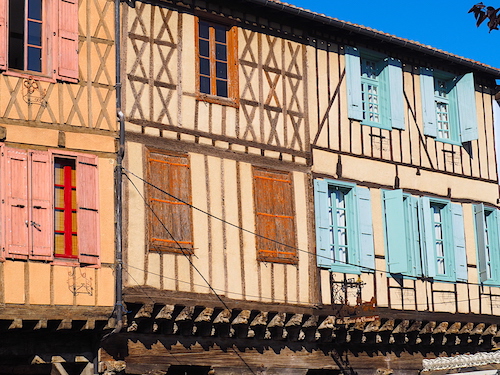
Lourdes – Hautes-Pyrenees
Taking all the minor roads rather than the speedy autoroutes, we meandered through the French countryside, keeping the snow-capped Pyrenees teasingly to our left. Little French villages in all states of attire imploring us to stay awhile. Although our destination was firmly in our heads; Lourdes in the Hautes-Pyrenees. It was a long hike, especially when SatNav took us on a circuitous route and we had to do a food shop and fill up with diesel. Still we arrived at Camping du Loup, a five minute walk from the famous town, ready for supper and bed.
Now Lourdes really does divide opinion. If you go in the Pilgrimage period, April to October then I sense it takes on a more sombre feel, as the town is filled with people searching for hope and a miracle cure to their ills. We visited at the end of November and loved the vibe and the lack of crowds. Whilst religion is of course Lourdes’ new identity, behind this are intriguing origins of its ancient market-town. The partnership between tourism and religion is a delicate one and as one of France’s most popular tourist destinations, secondly only to Paris, you may have to look beyond the shops selling bottles for the Holy water. After all, every book is more than its cover and we loved what the area had to offer in terms of activities, the possibilities of the funicular, the kayaking, the walking and the history. Whatever your religious beliefs, Lourdes is definitely worth checking out – especially out of season. Here’s our full blog on our visit – Lordy Lourdes
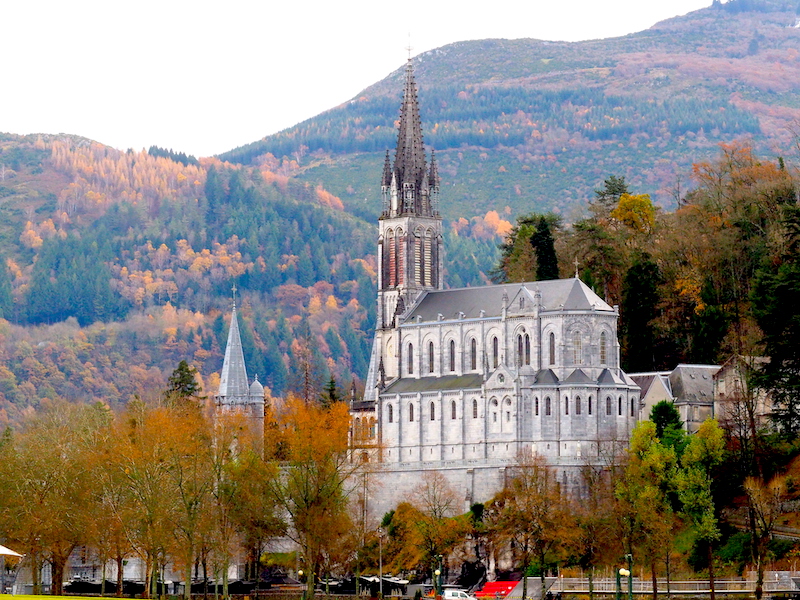
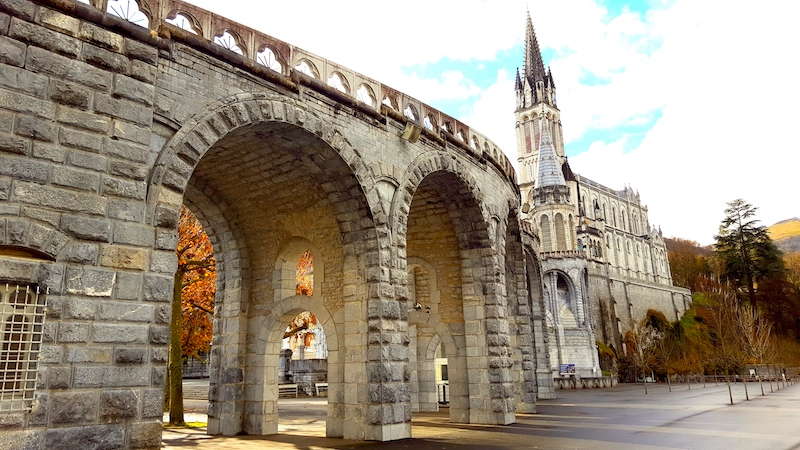
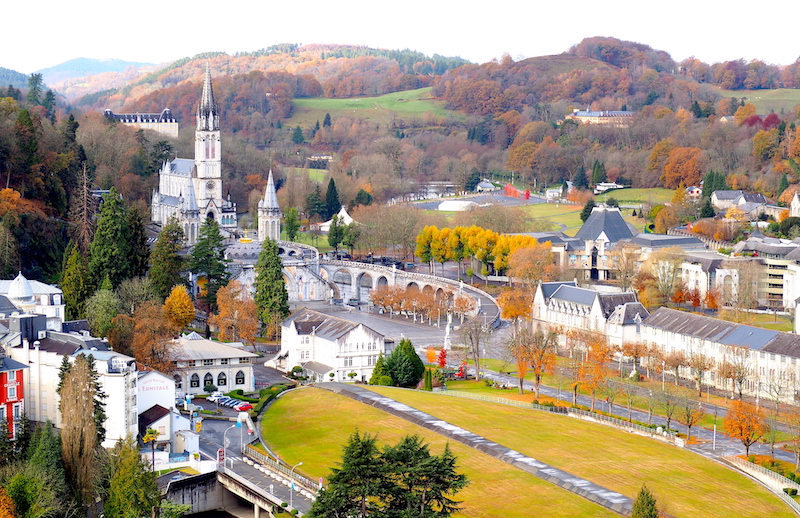
The Pyrenees via the Somport Tunnel into Spain
From Lourdes, we hot-footed it out of the Pyrenees as there was a threat of a big Arctic front coming in and the last place you want to be in a camper is in the mountains when snow hits. Our route took us towards Oloron, just south of Pau, along the valley floor, which was so lovely especially with all the autumn colours. Then a turn left heading south through the Pyrenees and the Somport Tunnel.
En route Red Kites flying on the thermals will distract your eye and the ever changing scenery of mountain communities will elicit the odd ‘ah’ from your delighted heart. Little villages clustered along the valley floor in the shadow of their towering protectors, prepare themselves for the harsh winter ahead. Smoke already billowing out from their chimneys, their wood piles strategically stacked in readiness for what will almost inevitably arrive. And the paternal dominance of these snow-peaked pinnacles command respect as the ever-changing weather swirls around their heads. The Somport Tunnel is temporary respite from the overwhelming feast for the eyes as you adjust to the darkness. Opened in 2003, this 8.3km tunnel has almost a magical feel to it, as you enter it in France and you exit it in Spain.
Canfranc Estación – The Titanic of the mountains
Our main purpose for taking this route was to check out the intriguing abandoned train station at Canfranc. Myles had read up on it and its mystery drove us to explore. It’s so easily missed, as no sooner are you out of the tunnel you hit the signs for the station. Blink and you will miss it.
Canfranc was put on the Spanish map when this out-of-place station with all its ostentatious grandeur was built in 1923, following the construction of the railway line and tunnel between 1912-1915. The station was formally opened in 1928 and it is the second largest in Europe; with its 240m long building, 365 windows, 156 doors and a platform of 200m. It remained open during WW2 as part of the Franco-Spanish International Convention, under which it was built, allowing some refugees to leave France into Spain.
Its life came to an abrupt end in 1970 when there was a derailment on a bridge on the French side and they could not afford to rebuild it. And today, with funds now available, this glorious building has turned from a ghostly station, to an elegant hotel. Just to park up outside and marvel at the architecture and reconstruct how this station buzzed and thrived in its day, is enough of an experience. There are plans to rebuild the line, with the agreement of the French Government, so new life will be breathed into this town after fifty years. It is definitely worth stopping off at.
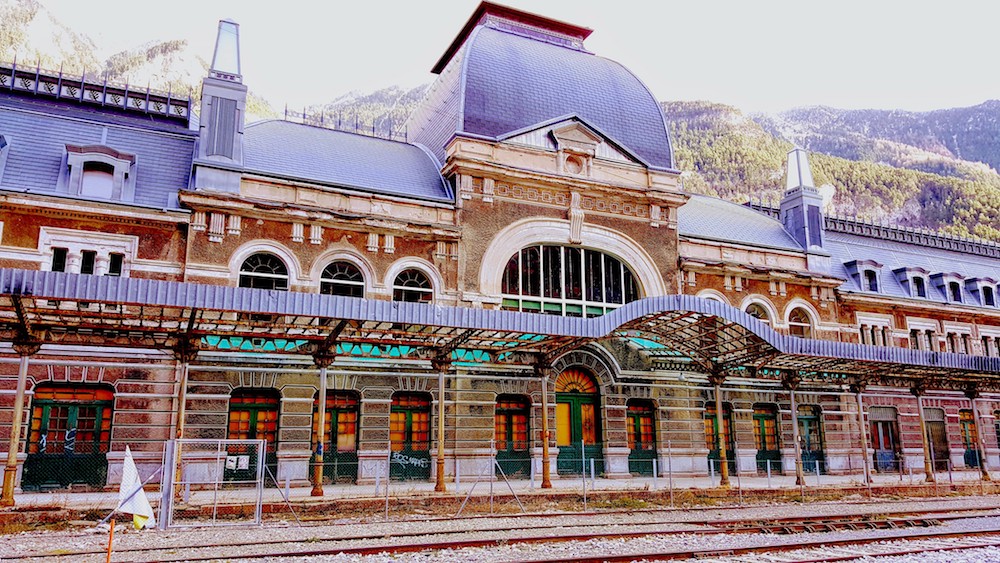
Jaca’s Monasteries – Aragon
We love exploring the hidden depths a place has to offer us curious travellers. It is all too easy to travel too fast and miss the secrets that lie just off the highway. So the region of Aragon was our explorative teacher.
After a short stopover at Jaca, a ski-resort with its ancient hexagonal fortress, we headed for the hills. Taking our route west, our chariot guided us into the foothills of the Pyrenees towards the Monastery of San Juan de la Peña. En route we were enthralled by Santa Cruz de la Serós, with its honey-coloured stone buildings and two Romanesque churches, one of which was an all-female monastery in its day. Just to wander around this tiny hamlet and through its cobbled streets carved into the hillside, was a delight.
Back on the road, which snakes up through the mountains, gives you an incredible view of the Pyrenees, so stopping for a photoshoot is essential. And then you come to the beautiful old Monastery carved into the rocks with its brand new cousin about 2km up the mountain which will wow you as you take in its size and splendour. It’s like a magical kingdom with its dominant reign over the plateaus and valleys beyond – it is such an interesting destination. There’s plenty of parking up there and a place to stop over night if you want to camp and unless there’s snow coming in, a great place to stop awhile and indulge in some walking.
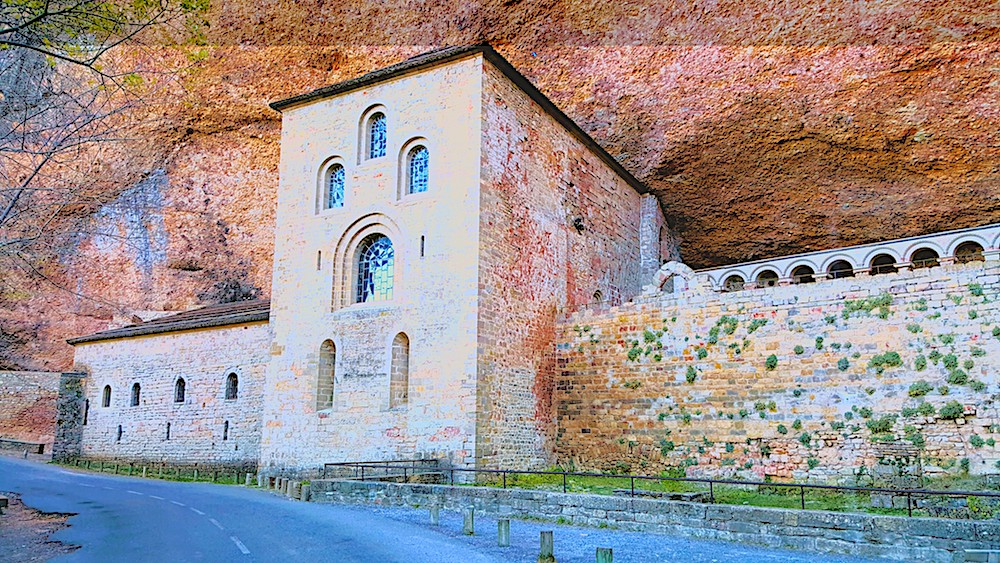
Laguna Gallocanta, Aragon
As our epic route with the motorhome continues, I found myself looking on the map for our next destination. If there’s anywhere that looks like a Nature Reserve that becomes a magnet for us as wildlife lovers. And so when I found Laguna Gallocanta purely by chance, it was our chosen detour. After doing some research I found that it is a winter stop-off point for cranes and is the most popular destination for these magnificent birds in Europe. So of course if became a beacon for us and in addition it was way off the beaten track, which had even more appeal.
So we headed on south past Zaragoza and turning off the motorway drove through some amazing countryside. At first it looks a bit bland although in fairness the snow did add a little more character. It didn’t take long though for us to take a few left turns and to see the whole landscape change dramatically. Twisting roads around rotund hills and valleys that looked like something out of the Hobbit and with its red soil gave a really atmospheric and beautiful drive. And then you approach Daroca, a fortress encased village, which out of nowhere stakes in claim from the surrounding landscape. We didn’t have the time to stop, as we’d been driving a while, although with its honey coloured buildings and fortress walls is definitely worthy of an explore.
Not far from Daroca, you will enter the tiny hamlet of Gallocanta, which is at the centre for the Nature Reserve and there is an Information Centre from where you can do Guided Tours from November to March and you can also stop over night at in the car park, which has views across the Lagoon. Now I will manage your expectations, as at this point of the year, sadly there was no water in the lagoon, so it looked a little sorry for itself, although the Cranes still came. You can’t get close to them by road or at the Information Centre, although you will see flocks of them coming in to land and with good binoculars will see them on the sandpits. It is a beautiful place to come – peaceful and so incredibly rural. Your exit from this region takes you on a narrow yet characterful road, through small Spanish villages with their ornate churches and cobbled streets that transport you into an authentic Spanish culture beyond the tourist magnetism of the cities and coast.
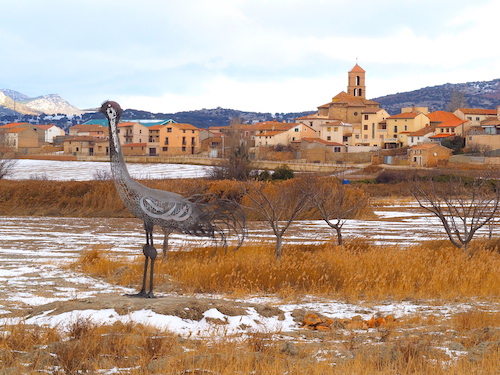
One of Spain’s ‘Most Beautiful Villages’ Alberracín, Aragon
As short drive away from Gallocanta, is one of Spain’s most beautiful villages. If it had a body like France’s Les Plus Beaux Villages, then Albarracín would most definitely be on it. From the motorway, much like so many places, you can’t imagine what it would be like and you are almost tempted to by-pass it, although the 20 minute deviation is definitely worthy of your turning wheels.
Once off the main plain, you turn into the mountains which are full of character, incredible sandstone eroded cliff faces and a gorge route that will have you enthralled. It is a superb drive. Yet strangely with the weight of expectation on its shoulders, as we approached Albarracín, we found ourselves disappointed. Surely this modern town with its industrial area is not all there is to see? Alas our patience was rewarded as, when we turned the corner, rising in front of our disappointed eyes, is the very reason we travelled here. A church steel adorned with white and green mosaics, an archway where the road travels underneath the village and sandstone buildings that nestled amongst the rocks protected by a fortress that curves around the village. This sight had us feeling instantly humbled and apologetic for ever having doubted it.
For the best experience of 11th Century Albarracín, approach the archway and then turn left, climbing up to the far end of the village and then tracking back towards the main centre. There are so many alleyways to explore and vistas that take your eyes over the gorge below, where the winding Guadalavia river of emerald green gives a real sense of this village’s Alcazar and Moorish roots. And one of the best bits about this town, is that is hasn’t lost its soul to the tourists. For sure there are restaurants and a few shops, although its authenticity is clear to feel as you wander around the streets. We almost felt intrusive, as the lives of the locals continue regardless of the milling crowd.
One of the things I loved best about this tiny village, in the middle of nowhere, is how the views changed around every corner. From the view of the arcing fortress defending the village’s honour, to the perspective from the fortress heights; views over the village walls to the gorge below and out through the windows of the castle remains to the land far away. And that’s before you even wander the streets looking at the quirky buildings, the architecture, the roof lines and the cobbled streets that feel like a maze at times. It is an atmospheric experience and you easily need 1/2 day to wander, absorb and climb to see the full picture of this little hideaway.
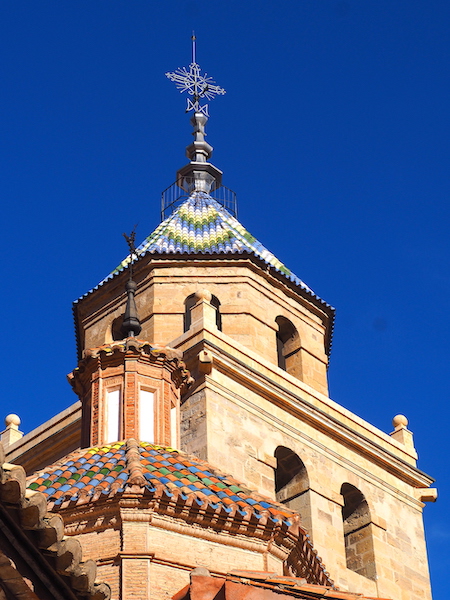
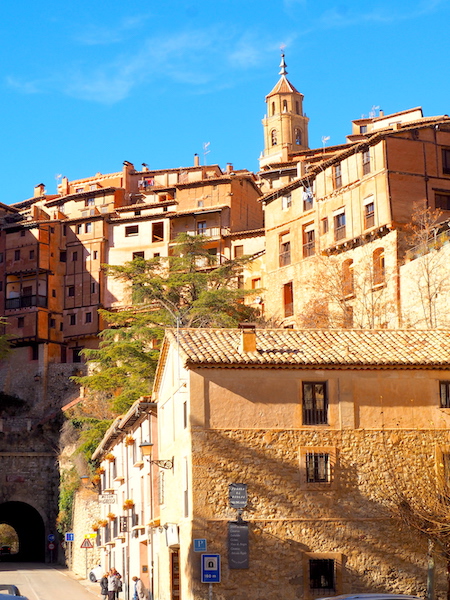
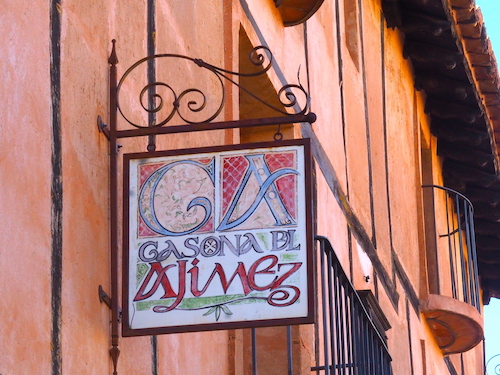
N330 Teruel to Utiel, Aragon
This epic route in the motorhome was certainly building momentum and it was about to become even more diverse.
After our little dalliance with Albarracín, we hot-footed it over to Teruel, which according to the Guide Books can be one of the coldest towns in Spain – hey we’re not scarred of a bit of cold. After all we’d just endured -11. We did have a quick trip into Teruel given we were so close, although we were disappointed. It was one of those towns, where the battle between old and new rages on and somehow the ancient world seems to be loosing out with modern culture consuming its precious history. Whilst there’s no denying that the main Plaza del Tourico is very pretty with its unusual buildings and undercover cafe bars and restaurants, trying to capture Teruel’s Mudéjar monuments, isn’t easy despite not being far apart from each other. You could almost do with having a Drone to rise up above the tightly packed buildings to really get the beauty of the cathedral and other iconic buildings that would have stood proud in their day.
Teruel needs to be visited as we’ve never seen architecture like it, although an hour will do perfectly well and then move on, as the countryside that is about to greet you is far superior, in our humble opinion. The N330 route is your travel guide for this part of the journey. Taking you away from the built up town and into the heart of a natural tapestry of ochre red and yellow rocks, filled with copious amounts minerals from eons beneath the sea. You could almost imagine yourself in a Spaghetti Western with the pillars of rock being akin to their American cousins and John Wayne galloping through the valley on his trusty stallion. Small villages, kilometres apart from each other, survive on the energy of the land and as the road winds around valleys, gorges and hilltops, you feel lost amidst its natural paradise. Your journey becomes timeless and the vistas entice you to travel slowly and mindfully until you reach Utiel for an overnight stop.

N330 south from Requena to Cofrentes, Valencia Community
The final stage of our journey south was the route from Utiel to Requena with a short diversion south on N330 towards Almansa. Here the vineyards create a patchwork across the countryside and then surrender to the pine-clad mountains. The road turns this way, then that, through the ochre walls and all we could see were acres of forest – oh and a couple of power station funnels! As our heart sank feeling that these blots on the landscape would ruin our experience – we held steady!
And patience brought us to the oasis of Cofrentes, which sits at the confluence of the rivers Júcar and Cabriel – hence its name, originating from the Roman name Confluentum. It is here you can try the regional dish of Gazpachos, eaten by many of the mountain workers and Orza which is a cured sausage. Food aside you have guided tours around Cofrentes’ Gothic Castle and El Cerro de Agras – the region’s only volcano, which still shows some activity by way of the Hervidieros Spa, where gas escapes from the chamber to a spring where the water looks like it is boiling. A river boat trip can be taken up the Júcar for 14km of the Júcar Route and if fishing is your thing, the pike and black-bass in the reservoir may appeal. January, May and August are their festival seasons where this tiny population gather as a community to honour their religious icons and celebrate together. For a tiny village in the middle of the mountains, this is where you can begin to experience, not only the mountain way of life, the true sense of inland Spain with its rituals and traditions. Walking, cycling, fishing – there’s plenty to amuse you in this mountain hideaway.
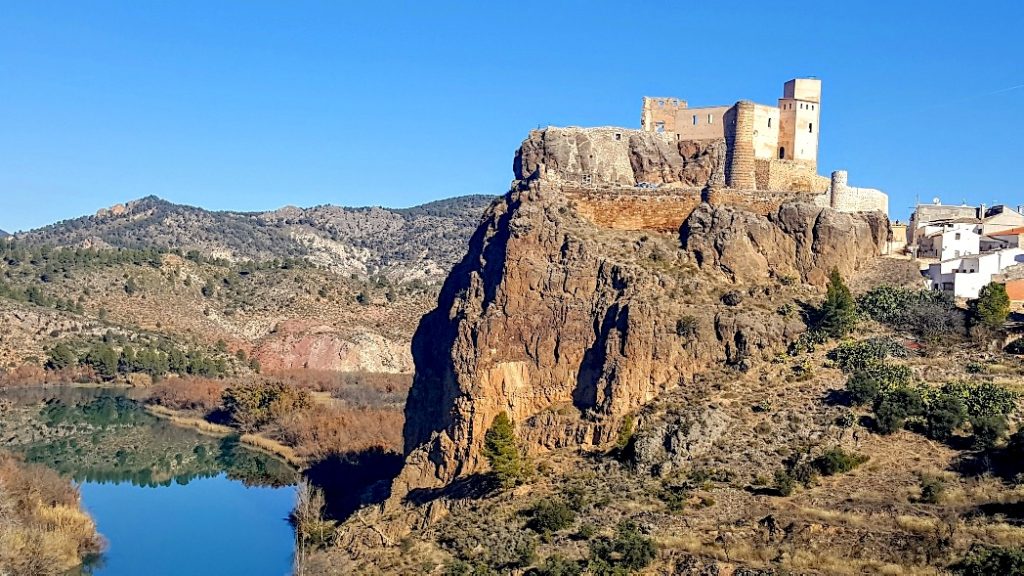
So this brings us to the close of our epic route with the motorhome from southern France into Spain, via the Aragon region. What a Christmas sack of gifts this was and how thankful we were not to rush through this area. Whilst we have by no means explored all its depths, we have at least a taster of Aragon’s presence and know for sure that we will return to uncover more of its delights. We hope that it might influence you to stop awhile and also unwrap its hidden depths.
Travel off the beaten track, drive slow, see much and learn plenty as you explore the land which has much to offer the curious explorer.

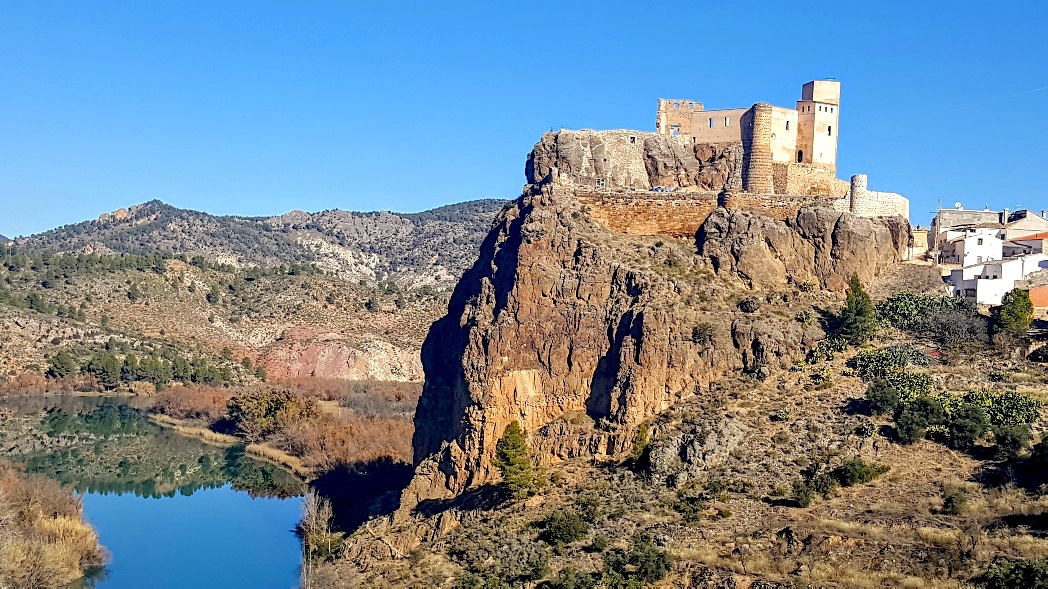
0 Comments